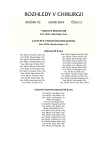Evaluation of safe resection margins in rectal carcinoma
Authors:
E. Hovorková 1; D. Hadži-Nikolov 1; A. Ferko 2; J. Örhalmi 2; M. Chobola 2; A. Ryška 1
Authors‘ workplace:
Fingerlandův ústav patologie LF a FN Hradec Králové, přednosta: Prof. MUDr. A. Ryška, PhD.
1; Chirurgická klinika, LF a FN Hradec Králové, přednosta: Prof. MUDr. A. Ferko, CSc.
2
Published in:
Rozhl. Chir., 2014, roč. 93, č. 2, s. 92-99.
Category:
Various Specialization
Podpořeno grantem IGA MZ ČR (NT13726-4/2012), grantem IGA MZ ČR (NT14150-3/2013) a projektem BBMRI LM2010004.
Práce je určena k postgraduálnímu vzdělávání lékařů.
Overview
The fact that surgically well performed total mesorectal excision with negative circumferential resection margin represents one of the most important prognostic factors in colorectal carcinoma is already well known. These parameters significantly affect the incidence of local tumour recurrence as well as distant metastasis, and are thus related to the duration of patient survival. The surgeon’s task is to perform mesorectal excision as completely as possible, i.e., to remove the rectum with an intact cylinder of mesorectal fat. The approach of the pathologist to evaluation of total mesorectal excision specimens differs greatly from that of resection specimens from other parts of the large bowel. Besides evaluation of the usual parameters for colon cancer staging, it is essential to assess certain additional factors specific to rectal carcinomas, namely tumour distance from circumferential (radial) resection margins and the quality of the mesorectal excision. In order to accurately evaluate these parameters, knowledge of a wide range of clinical data is indispensable (results of preoperative imaging, intraoperative findings). For objective evaluation of these parameters it is necessary to introduce standardized procedures for resection specimen processing and macro and microscopic examination. This approach is based mainly on standardized macroscopic photo-documentation of the integrity of the mesorectal surface. Parallel transverse sections of the resection specimens are made with targeted tissue sampling for histological examination. It is essential to have close cooperation between surgeons and pathologists within a multidisciplinary team enabling mutual feedback.
Key words:
rectosigmoid cancer – total mesorectal excision – circumferential resection margin – mesorectal excision quality assessment – interdisciplinary approach
Sources
1. Ferko A, Örhalmi J, Nikolov DH, Hovorková E, Chobola M, et al. Radikalita resekční léčby pro karcinom rekta. Analýza prediktivních faktorů spojených s nekompletní mezorektální excizí. Rozhl Chir 2013;92:304–10.
2. Dušek T, Ferko A, Örhalmi J, Chobola M, Nikolov DH, et al. Karcinom rekta do 10 cm. Srovnání radikality laparoskopické a otevřené operační techniky s ohledem na cirkumferentní resekční okraj a na kompletnost mezorektální excize. Rozhl Chir 2013;92:313–9.
3. Quirke P, Durdey P, Dixon MF, Williams NS. Local recurrence of rectal adenocarcinoma due to inadequate surgical resection. Histopathological study of lateral tumour spread and surgical excision. Lancet 1986;2:996–9.
4. Parfitt JR, Driman DK. The total mezorectal excision specimen for rectal cancer: a review of its pathological assessment. J Clin Pathol 2007;60:849–55.
5. Burroughs SH, Williams GT. Examination of large intestine resection specimens. J Clin Pathol 2000;53:344–9.
6. Dworak O, Keilholz L, Hoffmann A. Pathological features of rectal cancer after preoperative radiochemotherapy. Int J Colorect Dis 1997;12:19–23.
7. Gosens MJ, Klaassen RA, Tan-Go I, Rutten HJ, Martijn H, et al. Circumferential margin involvement is the crucial prognostic factor after multimodality treatment in patients with locally advanced rectal carcinoma. Clin Cancer Res 2007;13:6617–23.
8. Quirke P, Steele R, Monson J, Grieve R, Khanna S, et al. Effect of the plane of surgery achieved on local recurrence in patients with operable rectal cancer: a prospective study using data from the MRC CR07 and NCIC-CTG CO16 randomised clinical trial. Lancet 2009;373 (9666):821–8.
9. Nagtegaal ID, Quirke P. What is the role for the circumferential margin in the modern treatment of rectal cancer? J Clin Oncol 2008;26:303–12.
10. Nagtegaal ID, van de Velde CJ, van der Worp E, Kapiteijn E, Quirke P, et al. Macroscopic evaluation of rectal cancer resection specimen: clinical significance of the pathologist in quality control. J Clin Oncol 2002;20:1729–34.
11. Guillem JG, Chessin DB, Shia J, Suriawinata A, Riedel E, et al. A prospective pathologic analysis using whole-mount sections of rectal cancer following preoperative combined modality therapy. Implications for sphincter preservation. Ann Surg 2007;245: 88–93.
12. Mezhir JJ, Shia J, Riedel E, Temple LK, Nash GM, et al. Whole-mount pathologic analysis of rectal cancer following neoadjuvant therapy. Ann Surg 2012;256:274–9.
Labels
Surgery Orthopaedics Trauma surgeryArticle was published in
Perspectives in Surgery

2014 Issue 2
Most read in this issue
- Evaluation of safe resection margins in tumours of parenchymatous organs
- Evaluation of safe resection margins in rectal carcinoma
- Evaluation of safe margins in pathology examination in breast oncosurgery
- Clostridium colitis at a surgical department
